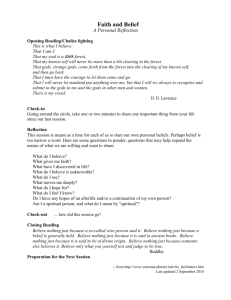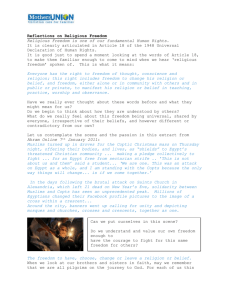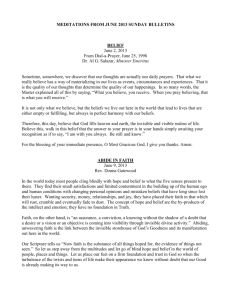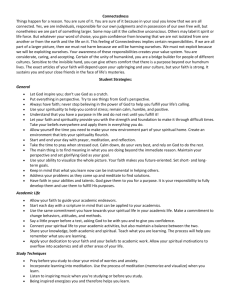Religion_and_Belief_2015
advertisement
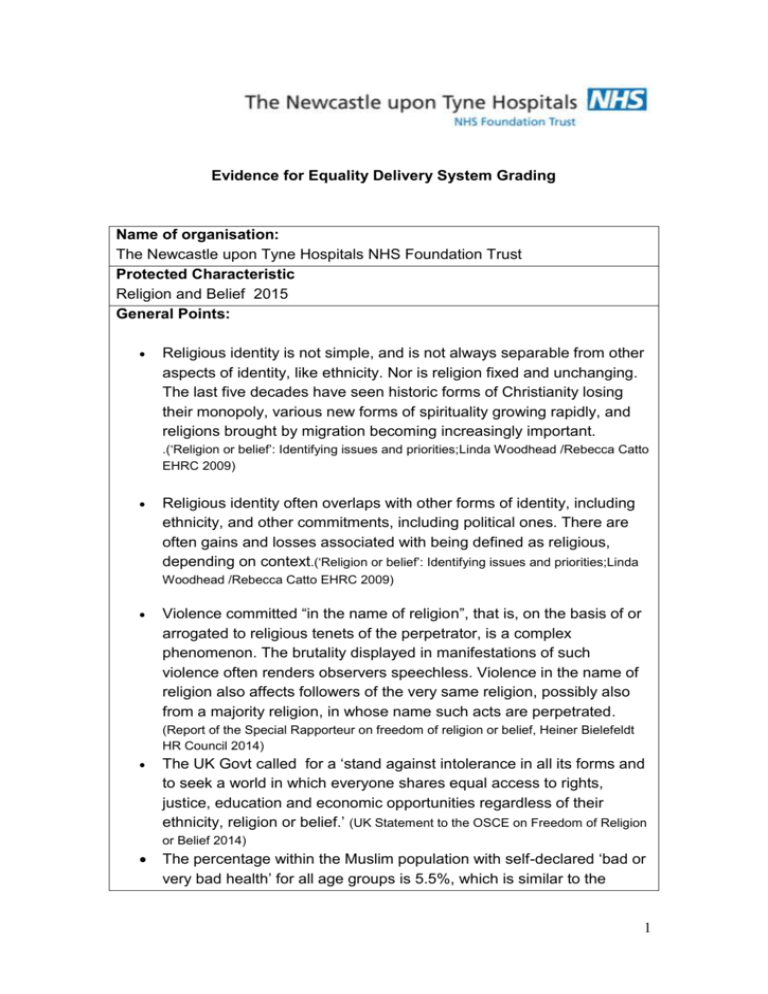
Evidence for Equality Delivery System Grading Name of organisation: The Newcastle upon Tyne Hospitals NHS Foundation Trust Protected Characteristic Religion and Belief 2015 General Points: Religious identity is not simple, and is not always separable from other aspects of identity, like ethnicity. Nor is religion fixed and unchanging. The last five decades have seen historic forms of Christianity losing their monopoly, various new forms of spirituality growing rapidly, and religions brought by migration becoming increasingly important. .(‘Religion or belief’: Identifying issues and priorities;Linda Woodhead /Rebecca Catto EHRC 2009) Religious identity often overlaps with other forms of identity, including ethnicity, and other commitments, including political ones. There are often gains and losses associated with being defined as religious, depending on context.(‘Religion or belief’: Identifying issues and priorities;Linda Woodhead /Rebecca Catto EHRC 2009) Violence committed “in the name of religion”, that is, on the basis of or arrogated to religious tenets of the perpetrator, is a complex phenomenon. The brutality displayed in manifestations of such violence often renders observers speechless. Violence in the name of religion also affects followers of the very same religion, possibly also from a majority religion, in whose name such acts are perpetrated. (Report of the Special Rapporteur on freedom of religion or belief, Heiner Bielefeldt HR Council 2014) The UK Govt called for a ‘stand against intolerance in all its forms and to seek a world in which everyone shares equal access to rights, justice, education and economic opportunities regardless of their ethnicity, religion or belief.’ (UK Statement to the OSCE on Freedom of Religion or Belief 2014) The percentage within the Muslim population with self-declared ‘bad or very bad health’ for all age groups is 5.5%, which is similar to the 1 overall population in this category of 5.4%. However for the age group of 50 years and above, it is 24.1% for Muslims, which is double the percentage for the population as a whole (12.1%). There are about 50 local authority districts where 40% or more of Muslim women over 65 years of age are in bad health. (British Muslims in Numbers The Muslim Council of Britain, January 2015.) Faith communities are an integral group of UK society, with the majority of the UK’s population identifying themselves as having some kind of religious faith or link to religious tradition and thousands actively participating in faith communities across the country. There are in excess of 11,000 faith leaders in the UK who can coordinate communities and who have experience, expertise and assets which are a valuable resource to the public.( Faith Communities and Pandemic Flu Communities and Local Gov 2009) Faith groups contribute significantly to the renewal of disadvantaged neighbourhoods. (Faith in the North East 2008 ) In 2001, 70.64% of people in Newcastle reported their religion / belief as Christian. Islam had the second largest number of followers at 3.63% of the population. (Followers of Islam are denoted as Muslim in the chart below.) 16% of people said they had no religion. Christian 70.64% Sikh 0.45% Buddhist 0.27% Other 0.19% Hindu 0.64% No Religion 16.02% Jewish 0.32% Not Stated 7.84% Muslim 3.63% It is helpful to distinguish between religion and spirituality. Spiritual needs may not always be expressed within a religious framework. It is important to be aware that all human beings are spiritual beings who may have different spiritual needs at different times of their lives. Although spiritual care is not necessarily religious care, religious care, at its best, should always be spiritual (Association of Hospice and Palliative Care Chaplains, 2003). Somebody’s spiritual understanding and practice is a key element of their well-being. What gives them hope, gives their life meaning, helps them make sense of things. So it is good to help a service user discover, foster, nourish this. It is as important as sleeping and eating. (Mary Ellen Coyte - Making Space for Spirituality Conference Report 2008) 2 One day, I disappeared from the hospital, as I wanted to do my prayers in private, but there was no quiet room where I could be alone with my thoughts and my prayers. I was not allowed to light a candle or incense stick, because of health and safety regulations. It was so difficult for me to practise my religion on the ward. (Poonam Choudhary- Making Space for Spirituality Conference Report 2008) In the wake of the 2001 ‘riots’ and the terror attacks of 11 September 2001 and 7 July 2005, Britain has experienced an intense political, media and policy scrutiny of British Muslims. These three events have triggered a two-fold approach to ‘managing’ Muslims – with a focus on securitization and migration control at the borders, and, internally, on issues of integration, cohesion and citizenship. Such policies have impacted on all dimensions of Muslim life, from travel ‘back home’ to the intimacies of marriage and family formation, from schools to prisons, from political protest to religious practice, from internet usage to stop and search, from friendships to mode of dress. The authors argue that discourses of securitization, segregation or Sharia law should recognise the multidimensionality of Muslim lives and their place within a broader struggle for equality, citizenship and social justice. (The New Muslims; 2013,Claire Alexander, Victoria Redclift and Ajmal Hussain. Runnymede press) There is specific quantitative evidence that the recorded number of incidents of anti-Semitism has increased since 2000, with an apparent peak in 2009, falling back somewhat in 2010, though to levels that are still higher somewhat higher than in the immediately preceding years. (Religious discrimination in Britain: A review of research evidence, 2000-10 CEHR) Some emerging evidence suggests the possibility of a changing pattern in relation to at least perceptions of ‘religious discrimination’ and/or readiness to pursue potential issues of such discrimination in which Christians are increasingly highlighting examples and concerns. (Religious discrimination in Britain: A review of research evidence, 2000-10 CEHR) Individual student social worker perspectives on and experiences of religion together with the informal views of colleagues determine whether and how religion and belief are acknowledged as significant and relevant. This reflects the findings of the RCN survey. (‘It Never Came Up’: Encouragements and Discouragements to Addressing Religion and Belief in Professional Practice—What Do Social Work Students Have To Say? Sheila Furness* and Philip Gilligan Br J Soc Work (2014) 44 (3): 763-781. doi: 3 10.1093/bjsw/bcs140) In our survey a member said “Spiritual care is a fundamental part of nursing currently much neglected through ignorance and misunderstanding”.(Spirituality in Nursing Care RCN 2010) Statutory bodies are often ill-equipped and ill-informed about the networks and processes for engaging with faith communities - there is a need for training in ‘religious literacy’. (Faith in the North East 2008 ) ‘Promotion of individual autonomy and human dignity is the most robust platform for protecting religious freedom.’ (Religious Freedom, Religious Discrimination and the Workplace Lucy Vickers Oxford, Hart Publishing, 2008, 240 pp (paperback £35.00) ISBN: 978-1-84113-687-5) Cultural differences This is offered as a key explanation for disparities in access to health services by BME populations. This explanation recognises that people identify themselves with a social group on cultural grounds, and that diverse racial and ethnic groups may respond differently because of their particular health beliefs and behaviours.32 Cultural dimensions highlighted include: religion that may affect compliance or access to services; sex, which is commonly mentioned as an obstacle to service access by women; differential presentation including “somatisation” of symptoms, which is reported to lead to misunderstandings, misdiagnosis, or incorrect referrals; “fatalism” or shyness, which may also lead to a reluctance to seek help resulting in late presentation; and other cultural factors such as family dynamics may mean people cannot easily attend or take up services without the support of family members.2 It is recognised also that health professionals need to take into account these types of cultural beliefs and values when communicating with patients or users. (Access to health care for ethnic minority populations A Szczepura Postgrad Med J 2005;81:141-147 i:10.1136/pgmj.2004.026237) There are many views on dying, death and life after death. Finding out about individual wishes and practices is an important part odf a good death. The views of religious leaders from the Noth East can be viewed at: http://www.phine.org.uk/a-good-death (What is a good Death; Public Health North East/ Regional Faiths Network 2012) 4 Points related to Age For many religions, life does not end with death. Often the process of dying is seen as an opportunity for spiritual insight. (Religion or belief: A practical guide for the NHS DH 2009) Points related to Disability Religion and spirituality are important coping strategies for some people with disabilities. (Religion and disability: Clinical, research and training considerations for rehabilitation professionals, 2007, Vol. 29, No. 15 , Pages 1153-1163 Brick Johnstone, PhD1†, Bret A. Glass2 and Richard E. Oliver3) Issues of spirituality are all-pervading in mental health services and we all have a responsibility to ensure that these issues receive a higher awareness. (Dr Andrew Fairbairn, Making Space for Spirituality Conference Report 2008) Points related to Race Prejudice and discrimination is increasingly about religion and religious identity as well as about race and racial identity. We all have to do all we can to challenge prejudice and racism. Pluralism is essential to our well being. Faith diversity is part of our richness and requires from us all a deep respect for each other. ( One Country Many Faiths 2007) Religion and belief may be very important to some black and minority ethnic people, staff need to be aware of religious beliefs of patients and service users. (Religion and Belief Factfile 2010) It is important to remember that people are individuals. When planning and delivering care, every effort should be made to find out individual preferences and attitudes towards religion as well as individual views on family responsibilities and cultural traditions.(Embracing Diversity in Mental Health 2010) Community and religious leaders can be a health promotion resource, reinforcing messages about ways to stay healthy and how to avoid developing or worsening long term conditions. (Exploring health and social care needs of people in black and minority ethnic communities in North Tyneside. McNulty and Ahad 2010) Points related to Marriage and Civil Partnership The Marriage Act now allows for marriage between same sex couples but the Church of England is excluded from conducting marriage services for same sex couples. 5 Points related to Pregnancy and Maternity Many religions have different practices that have to be performed during labour and on the birth of a child. (Religion or belief: A practical guide for the NHS DH 2009) Points related to Sex (Male/Female) Some people think FGM is an important part of their religion. There is no evidence to suggest that FGM is required by Islam, Christianity, Judaism or any other religion. Islamic scholars around the world have condemned the practice of FGM and are clear that FGM is not an Islamic requirement. Islamic scholars and clerics have stressed that Islam forbids people from inflicting harm on others, and that those putting their daughters through FGM, or carrying out or aiding FGM, are going against the teachings of Islam. FGM is not only practised by Muslims but is also common among Christians, particularly Coptic Christians in Egypt, Sudan, Eritrea and Ethiopia. There is no evidence in the Bible to suggest that FGM is required by Christianity. FGM also takes place among some Bedouin Jews and Falashas (Ethiopian Jews). Although Judaism considers circumcision essential for males, it does not require the practice for females. Points related to Sexual Orientation Ellison and Gunstone (2009) found that 53% of their survey reported to belong to a religion, but only 37% of gay men and lesbians. They found a smaller proportion of gay and lesbians to be from an ethnic minority group (1.4% compared to 3.5% of white respondents). Stonewall’s report, Living Together, a survey with over 2,000 nationally representative people in the UK, found that people of faith are no more likely to be prejudiced against lesbian and gay people than anyone else. Organisations are confident that they are able to take steps to prevent and respond to discrimination against lesbian, gay and bisexual people. They are less confident about tackling negative attitudes and responses when these are justified and motivated by religion and belief. They acknowledge that incidents are very rare and that working to prevent such incidents is a priority. (Religion and Sexual Orientaion in the workplace) Many conventional religions conform to ‘the heterosexist-norm’, most 6 being oppressive to LGBT people. (Mackereth and Ash 2010) Many LGBT people struggle in society to reconcile sexuality, culture and faith. ( Macaulay,RJ) Ethnicity and Inequalities in Health and Social Care • Volume 3 Issue 3 • September 2010 © Pier Professional Ltd) Points related to Transgender Research has generally considered prejudice is linked to sexism and the associated definition of rigid gender roles. Mitchel and Howarth suggest that, a lack of toleration of diversity and difference in particular institutions such as the media and religion needs to be investigated. Some participants in theTrans Community Statement of Need Workshop considered that more and more Christian people/groups are accepting of trans people,others considered that some religions seek to damage trans rights and acceptance. (Trans Community Statement of Need Workshop Summary GEO 2011) Examples of how we meet needs Chaplaincy Team – see information below Updated guidance on Religion and Belief ‘Spirituality’ Campaign and resources Clothes Bank in partnership with Mothers Union Religion and Belief Fact File Representation on EDHR Group Links with leaders of many faith groups Links with regional R&B Staff Network Supporting Equality Week Putting Patients at the Heart of Everything we do’ resource Development of new guidance for staff on religion and belief with some straight forward questions to help them find out about patients spiritual needs Celebration of World Religion Day Sikh perspectives on Patient Care workshop in Equality Week and Jewish perspectives within the Nursing and Midwifery Conference Multi-faith Safeguarding information Multi-faith Health Care Resource for staff Honorary Chaplaincy programme developed. Honorary Jewish 7 Chaplains appointed and a programme for Muslim Chaplains is being developed. Information about food provided in hospital including Kosher and Halal and spiritual care - disseminated to community organisations via HAREF Work of Chaplaincy Team The document below highlights some of the work of the Chaplaincy Dept. chapliancy - policy leaflet.doc Training delivered by the Chaplaincy Team Training for Children’s Paediatric Cardiology Services in response to survey with staff Market Place at induction – weekly End of Life/Bereavement – weekly 2 day Bereavement Course Student Nurse and Midwife Induction Preceptorship training Health Care Assistant programme Spiritual and Religious needs on Communication Training Training for individual wards and departments 8

